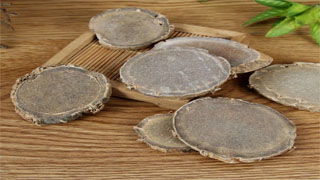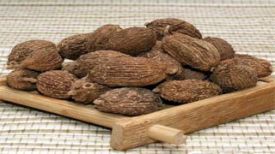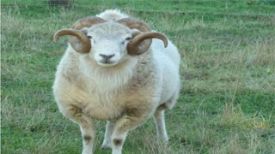
1. Alias
Wen E, Peng Shu, Qiang Qi, Guang Shu, Hei Xin Jiang, Wen Shu.
2. Plant morphology
Perennial herb. The root is slender, and the end swells into a fleshy spindle shaped tuber, with a yellow green or nearly white cross-section. The main stem is cylindrical, the lateral rhizomes are finger shaped, and the cross-section of the rhizomes is light blue, light green, yellow green to yellow. Leaves stand upright, with 4-7 rows of leaves; The leaves are oblong elliptical or oblong lanceolate in shape, with a pointed tip and a narrowed base. The lower part is sparsely covered with short hairs, and there are purple bands along both sides of the midrib on the upper part of the leaf that reach the base. The midrib is green. The spike shaped inflorescence is extracted from the rhizome, cylindrical in shape, with over 20 bracts; Crown lobes are red; The degenerated stamens are smaller than the lip, with a yellow lip and an inverted egg shape. Capsule.
3. Origin distribution
Born on mountain slopes, near villages, or in semi shaded wetlands under forests, it is also cultivated. Distributed in Zhejiang, Jiangxi, Fujian, Taiwan, Hunan, Guangdong, Guangxi, Sichuan, Yunnan and other places.
4. Harvesting and processing
After the stems and leaves wither in winter, they should be harvested, washed, steamed or boiled until they are fully penetrated, dried in the sun or at low temperatures, and then the roots and impurities should be removed.
5. Characteristics of medicinal herbs
Pongzhuo: ovate, long ovate, conical or long spindle shaped, with a blunt pointed tip at the top and a blunt rounded base. The surface is gray yellow to gray brown, with raised upper segments and circular slightly concave or residual fibrous roots. Some have one row of sunken bud marks and nearly circular lateral root and stem marks on each side, while others have visible knife cutting marks. Weight, solid texture, gray brown to blue brown cross-section, wax like, often accompanied by gray brown powder, easy separation of cortex and central column, and brown ring pattern of inner layer. The aroma is slightly fragrant, and the taste is slightly bitter and spicy. Guangxi Curcuma: The links are slightly raised, the cross-section is yellow brown to brown, often accompanied by light yellow powder, and the inner layer has yellow white ring patterns. Wen'e technique: The cross-section is yellow brown to brownish brown, often accompanied by light yellow to yellow brown powder. Fragrant or slightly fragrant.
6. Sexual Taste Returning to the Classics
Warm in nature, spicy and bitter in taste. Returning to the Spleen Meridian and Liver Meridian.
7. Effect and Function
Promote qi circulation, eliminate blood stasis, and relieve pain. Belonging to the category of blood activating and stasis removing drugs, it is a blood breaking and syndrome reducing drug.
8. Clinical application
Take 6-9 grams and decoct; Or into pills or powder; External use: appropriate amount, boil soup and wash; Or apply it at the end of the study. Used for treating symptoms such as lumps, blood stasis, menstrual flow obstruction, bloating and pain caused by food accumulation, and early cervical cancer.
9. Pharmacological research
It has the effects of anti-tumor, antibacterial, increasing white blood cells, promoting blood circulation and removing blood stasis; Low concentration tension and high concentration relaxation of gastrointestinal smooth muscle; Has a hepatoprotective effect; Has an improving effect on acute renal failure; Inhibit platelet aggregation and prevent thrombosis; Has anti-inflammatory and other effects. The clinical use of Curcuma zedoaria oil injection for intravenous infusion has achieved good therapeutic effects on thromboangiitis obliterans, and has shown good efficacy in treating infantile RSV pneumonia without any side effects. Oil preparations have anti-tumor effects and have certain therapeutic effects on ovarian cancer, malignant lymphoma, lung cancer, and liver cancer.
10. Chemical composition
This product mainly contains chemical components such as volatile oils, flavonoids, terpenes, etc. The main ingredients include curcumin, curcumin, camphora, daidzein, camphor, gingerol, gingerol, curcumin, curcumin, coumarin, β - sitosterol, palmitic acid, etc.
11. Usage taboos
Pregnant women are prohibited from using it.
12. Compatibility prescription
① Treat acid swallowing and vomiting: 30g of Curcuma zedoaria and 15g of Coptis chinensis (boil 15g of Evodia rutaecarpa together, remove Evodia rutaecarpa). Boil it in water. (Danxi Heart Method)
② Treating women with blood clots and amenorrhea: 30g each of Curcuma zedoaria and Polygonum multiflorum, 30g cooked rhubarb. The pills are as big as mung beans, take ten or twenty pills per serving, and put them in white soup. (Shenzhai Testament)
③ Treating women's blood and qi attacks the heart, unbearable pain and walking away. Injection: 15g Curcuma (fried in oil and sliced), 0.3g Xuanhusuo. Above is fine powder. Take 1.5 grams per serving and adjust to light vinegar soup before consumption. (Xuanhu Suo San from "Jifeng Puji Fang")
④ Treating injuries and pain: 30g each of Curcuma zedoaria, Bombyx mori, and Sumu, and 15g myrrh. At the end. Take 6 grams per dose, boil in water and warm, take three to five doses per day. (Bo Ji Fang, Peng E San)
⑤ Treating lacquer sores: Wash it with Curcuma zedoaria and Guanzhong decoction. (Pope Francis)
⊙ The content of the article is for clinical reference only. Non TCM professionals are not allowed to test drugs.


